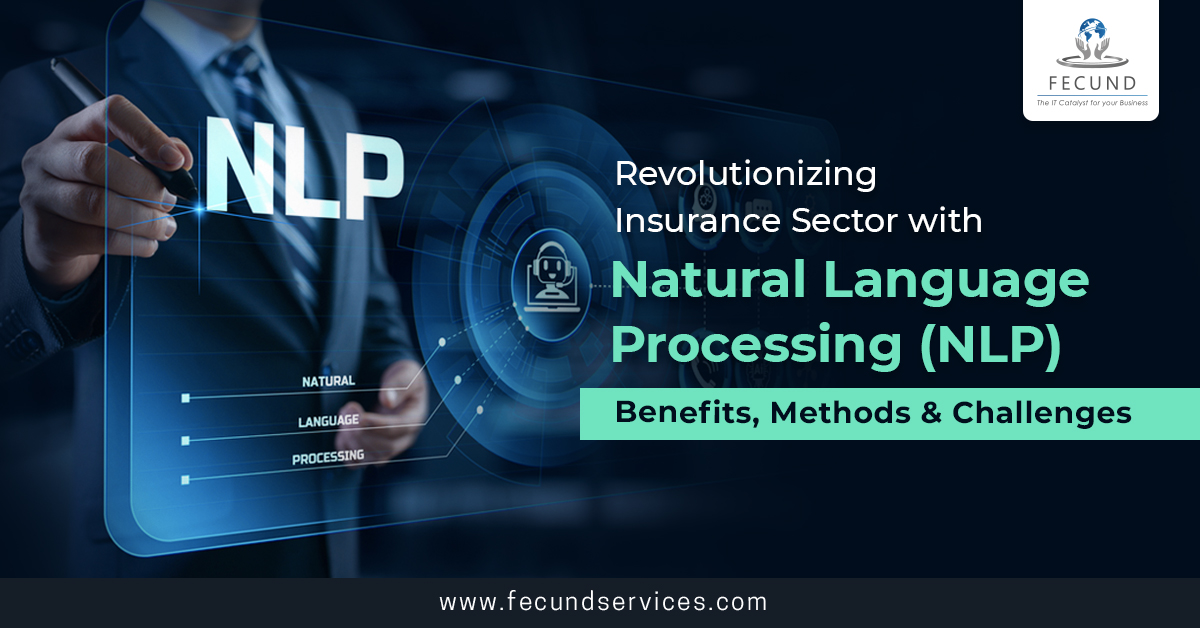
In the insurance industry, Natural Language Processing (NLP), a subfield of artificial intelligence, has made tremendous progress. NLP is the practice of understanding, interpreting, and producing human language using computer algorithms. NLP algorithms can find patterns and insights in text and speech that would be challenging for humans to notice. NLP is used in the insurance sector, among other things, to enhance customer service, risk assessment, and fraud detection.
Customer service is one of the most exciting applications of NLP in the insurance industry. NLP algorithms can identify frequent problems and offer recommendations about how to enhance customer service by examining client feedback and complaints. An insurance company, for instance, might utilize NLP to examine client feedback posted on social media or review websites. The business can target improvements to its customer service procedures by identifying common complaints, such as prolonged phone waits or unclear policy language.
In the insurance sector, NLP is utilized for risk assessment. The likelihood that a consumer will submit a claim can be predicted using NLP algorithms by looking at information like their age, location, and health state. This aids insurance providers in determining premiums that fairly represent the degree of risk attached to each policy.
What is NLP?
Natural Language Processing (NLP) is a field of artificial intelligence that focuses on enabling machines to understand human language and communicate with humans in a natural way. NLP is used to extract meaning from text and speech data, which can then be used to generate responses, answer questions, and perform other tasks.
How does it work?
NLP is a set of techniques for computers to understand natural language as humans do. NLP can be applied to spoken or written language, regardless of its meaning or context. Artificial intelligence is utilized by natural language processing to interpret real-world data and present it in a computer-readable format. Just like humans possess different sensory organs to perceive the world around them, such as ears for hearing and eyes for seeing, computers rely on programs for reading and microphones to capture audio. Similarly, humans have a brain that processes these inputs, converting them into understandable information, while computers have programs that perform the same function by transforming their inputs into code. At some point in processing, the input is converted into code that the computer can understand; this is called preprocessing.
Data preprocessing involves the process of preparing and cleaning text data for machines to analyze it. This is done by breaking down the text into smaller units that a computer can work with, such as words or phrases (Tokenization). It also involves removing common words from the text so that unique words that offer the most information about the text remain (Stop Word Removal). Data preprocessing also involves marking words based on their part of speech — such as nouns, verbs, and adjectives — which allows algorithms to better understand what they mean. Once the data has been preprocessed, an algorithm is developed to process it. The two most common approaches are rules-based systems and machine learning-based systems. Rules-based systems use carefully designed linguistic rules; machine learning-based systems use statistical methods that learn to perform tasks based on training data they are fed, then adjust their methods as more data is processed. These approaches hone their own rules through repeated processing and learning.
Why is it needed?
Businesses use massive quantities of unstructured text-heavy data, and they need a way to process it more efficiently. A lot of the information created online and stored in databases is natural human language. Until recently, businesses could not effectively analyze this data because they couldn’t easily extract meaning from it. This is where natural language processing becomes useful.
NLP methods
Natural language processing relies on two main techniques: syntax and semantic analysis.
Syntax refers to the way words are arranged in a sentence to create grammatical meaning. In NLP, the syntax is used to derive meaning from language by following grammatical rules. Some techniques used for syntax include:
Parsing: the process of grammatically analyzing a sentence to break it down into parts of speech. For example, the sentence “The dog barked” would be parsed as “dog” (noun) and “barked” (verb). This technique is helpful for more complex NLP tasks.
Word segmentation: the act of separating words from a string of text. For example, an NLP algorithm can analyze a handwritten document and recognize where the spaces are between words.
Sentence breaking: the process of identifying sentence boundaries in large texts. For example, an algorithm can recognize that the text “The dog barked. I woke up.” contains two separate sentences.
Morphological segmentation: the process of breaking down words into smaller parts called morphemes. For example, the word “untestably” can be segmented into “[[un[[test]able]]ly]”, where “un,” “test,” “able,” and “ly” are recognized as separate morphemes. This technique is particularly useful for machine translation and speech recognition.
Stemming: the process of reducing inflected words to their root form. For example, an algorithm can recognize that the word “barked” in the sentence “The dog barked” is derived from the root word “bark.” This technique is helpful for identifying all instances of a particular word, regardless of its conjugations.
Semantics is concerned with the meaning and usage of words, while natural language processing utilizes algorithms to comprehend the structure and meaning of sentences. Semantics techniques include:
Word sense disambiguation, which determines a word’s meaning based on context. For instance, an algorithm could decipher that the word “pen” in the sentence “The pig is in the pen” refers to an enclosed area, not a writing instrument.
Named entity recognition, which groups words into categories. For example, an algorithm could analyze a news article and identify all mentions of a particular product or company. By considering the context, it would be able to distinguish between visually identical entities. In the sentence “Daniel McDonald’s son went to McDonald’s and ordered a Happy Meal,” the algorithm could recognize the two instances of “McDonald’s” as distinct entities: one a restaurant and the other a person.
Natural language generation employs a database to ascertain the semantics of words and produce a new text. One example of the application of algorithms is the automatic creation of a summary of business intelligence platform findings. This is accomplished by mapping certain words and phrases to specific data features. Another scenario where algorithms can be employed is the automatic generation of news articles or tweets, which is based on a text corpus used for training purposes.
Benefits of NLP in the Insurance Sector
- Claim processing is a critical function in the insurance industry, and it has been responsible for many problems. However, because NLP technology can analyze both speech and text faster than humans and combine them with OCR models to access large amounts of customer information connected with previous claims, customers can be guided by NLP-powered chatbots to take videos and photos of the damage, which can then be instantly converted into the first notice of loss.
- Underwriters are responsible for examining numerous policies and documents in order to reach key conclusions. They need to have an accurate understanding of the data they have, as well as its reliability. NLP can help them save time by extracting relevant information from large datasets more quickly than humans can.
- Insurance companies have long struggled with fraud. In the past, they have used both traditional and experimental technologies to battle insurance fraud; however, those techniques are not as effective as NLP technologies. Insurance companies deal with massive amounts of data and manually review claims notes and other documents such as emails or text messages. Because they always must deal with a large number of documents, NLP is a useful tool for investigative procedures. It can save them time and help them complete the investigation in less time by providing a classification of these documents through machine learning algorithms.
- Improving Customer Experience. Enhancing the customer experience has become a top priority for insurance providers, with over 80% of customers expressing a desire for personalized offers, pricing, recommendations, and messaging. Natural Language Processing (NLP) can help achieve this goal by enabling virtual assistants to understand and respond to natural language. By integrating NLP technology into virtual assistants, insurers can provide a personalized experience to customers, automating responses and providing accurate answers quickly and efficiently. AI-powered virtual assistants are typically more effective than human agents in these tasks, making them an increasingly popular choice for improving customer satisfaction in the insurance industry.
- In the wake of the COVID-19 pandemic, cost reduction and efficiency improvements have become essential expectations for 67% of consumers, according to a Celent report from April 2020. The insurance industry faces financial and logistical challenges on a regular basis, and these have only been exacerbated by the pandemic. However, NLP technologies have been proven to provide solutions that can help address these challenges. In fact, a 2019 study by LexisNexis found that 88% of surveyed insurers were already seeing benefits from the implementation of AI-based solutions for claims settlements. As NLP technology continues to evolve, insurers are discovering new and innovative ways to use it to their advantage.
Challenges
Natural language processing faces several challenges due to the constantly evolving and often ambiguous nature of natural language. These challenges include:
Precision: Computers require precise, unambiguous, and structured language to process information, but human language is often imprecise and dependent on complex variables like slang, regional dialects, and social context.
Tone and inflection: Current natural language processing techniques struggle with semantic analysis and understanding abstract language, such as sarcasm. Tone and inflection in speech can change the meaning of a sentence, and different accents can pose difficulties for algorithms to interpret.
Evolving language use: As language continues to change over time, NLP algorithms may struggle with hard computational rules that become outdated. Language rules are not fixed and may be subject to change with time, making it challenging to create algorithms that can keep up with real-world language use.
Conclusion
The insurance industry is poised for a technological revolution that will enhance underwriting, risk assessment, and customer service through the use of data analytics and new technologies. The traditional insurance model may be disrupted further by the emergence of insurtech companies, which may introduce innovative products and services. To reach and engage customers, insurers are expected to leverage digital channels such as mobile apps and online portals. Providing a superior customer experience will remain a top priority, as insurers strive to offer tailored products and services that cater to individual preferences and needs. Additionally, sustainability is likely to play a larger role in the insurance industry, potentially leading to the creation of more eco-friendly products and practices.

Author Bio: Mayank Jadaun is a seasoned IT professional with over 3+ years of experience in Guidewire, project management, and business analysis. Currently serving as a Software Engineer at FECUND, Mayank has a strong track record of delivering complex solutions and driving digital transformation for his clients. He holds a Bachelor’s degree in Engineering from the Indian Institute of Technology, Roorkee, and has completed various professional certifications in project management, insurance domain, and software development. He is a Guidewire Certified professional too. LinkedIn Profile




Post a comment